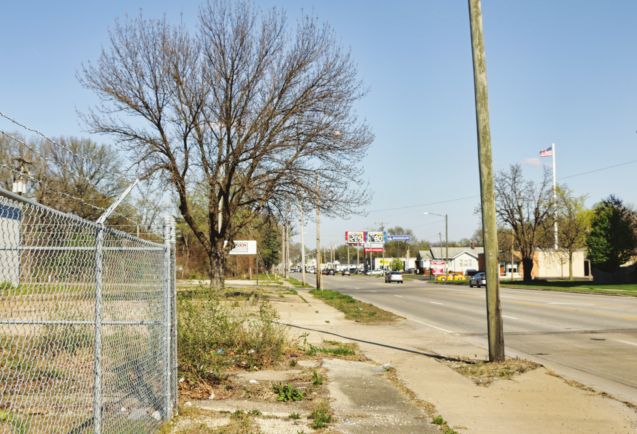
Re-treeing Springfield means transplanting attitudes too
Careful readers of his paper will know that Sustainable Springfield is encouraging businesses and landowners to allow the organization to plant native and/or noninvasive tree species on their properties, starting with the Clear Lake Avenue corridor.
Any proud native who wishes Springfield to make a good impression on visitors might wish that trees be planted not along Clear Lake Avenue but smack in the middle of it, because that would force visitors to drive into the city via some less ugly route. Alas, Clear Lake is a state highway, and the State of Illinois might retaliate against the city by not paying its social service providers or cutting the budget of the local state university or putting off needed infrastructure investments or . . . .
Sorry. Where was I? The question occurs, why have property owners not planted trees along Clear Lake already? Is it lack of space? Money? Allergies? Because they fell out of a tree when they were little and got a booboo? I suspect not. To the arborphilic, a tree is a hope, a dream, a string of nature’s breezy harp, but to a lot of people a tree is a just another weed.
I used to think that there lies, deeply embedded in our genes, some atavistic anxiety about being among trees; trees offered concealment to the fearful hominid but they also concealed the animals (including other humans) that stalked them. But reviewing comments posted at realty and garden websites I find no mention of unease among today’s tree-haters, just annoyance at the housekeeping that trees entail. (Never mind that most tree problems are created by the owner when they choose a species that will get too big for the space or has known bad habits.) Many of even our more sophisticated property owners who accept that mature trees add value prefer that the trees be near, not on, their property.
I am among those who regard the stretch of South Grand Avenue west of MacArthur to be genuinely grand because of its street trees, which enclose the street but, because of their height, never make it feel closed in. That upscale enclave was developed at the turn of the 20th century. Newer versions of it present a very different prospect. The streets around the Panther Creek country club, for example, are adorned by hardly any street trees. Such trees as were planted on the adjoining yards are small and most will stay small, they being semi-dwarf, lollipop trees like the ubiquitous flowering crabapple. Pretty and polite, such ornamentals die young and never leave a memory. They never offer shelter to anything larger than a robin, never grow tall enough to shade a house, never will be majestic or handsome. Because of this, Panther Creek to me still has that notquite-finished look of a new subdivision, some 25 years after it opened.
The purpose of the protective covenants imposed on buyers of lots in a newer subdivision nearby is in part “to preserve, as far as practicable, the natural beauty” of each lot. Trees already growing on a lot can’t be destroyed unless it’s necessary in order to build. Trees fatter that four inches that survive the construction cannot be cut down without the OK of an “architectural control committee” named by the developer. If no tree already stands in the yard fronting the street, the owner must plant two – any tree will do.
These are paltry protections even by Illinois standards. Compare them to Barrington, the upscale northwest Chicago exburb. That town demands that new house builders replace elsewhere on the lot every tree lost in construction, inch for inch and type for type. In the news recently was the case in which house construction required the removal of 25 “heritage” trees (defined by Barrington as hackberry, basswood, sugar maple, ironwood and various types of oaks) totaling 438 diameter-inches. The town ordered them replaced on the finished lot with 110 heritage trees that were each four inches in diameter, and when the owner failed to comply the town refused them an occupancy permit.
That, friends, is a Tree City USA. Some readers will be aghast at this kind of this aggressive stewardship of trees on private land. Others will lament that public regulation is necessary in the first place. I doubt that Barringtonians are any more enamored of trees than Springfieldians, but 1) they have the money to pay people to do tree-related chores and 2) it is a small price to pay for the privilege of living in Barrington.
And why does Barrington insist on such standards in the first place? Because they add beauty to the place. It’s a tree thing. You either get it or you don’t.
Contact James Krohe Jr. at [email protected].
Editor’s note
There is no more apt description of the just concluded legislative session than Gov. Bruce Rauner’s: “Stunning failure.” He was pointing at the Democrats, as usual, but he is the one who failed the most, by failing to propose and win approval for a reasonable budget, and by failing to help business with cost-saving reforms to workers’ compensation or anything else. Especially in the capital city, business is suffering under this governor. The UIS Survey Research Offi ce this week released its March study of Sangamon County business leaders’ perceptions. More than half said state government’s fi nances are the biggest challenge to their businesses in the next year. The fact that the governor has backed off his non-budget agenda at least until after the November election, and has agreed to reopen the Illinois State Museum, offer some reason for hope. Democrat leaders have agreed to negotiate over the governor’s stopgap funding bill, which will give Rauner more opportunity to become more of a problem-solver, less of a problem. –Fletcher Farrar, editor and publisher